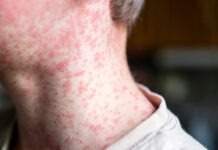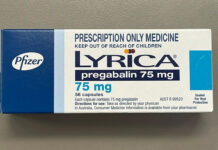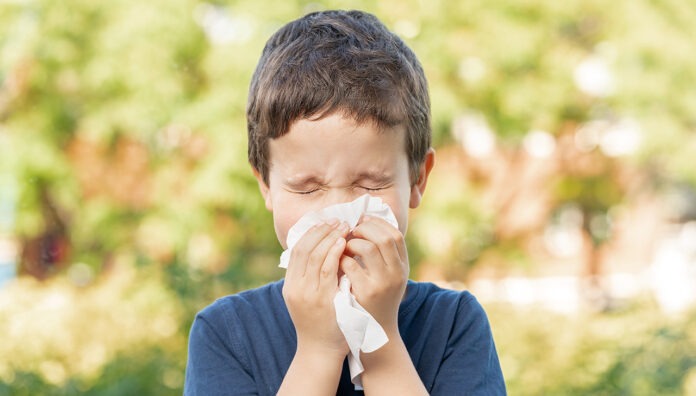
Despite being the most prevalent allergic disorder in Australia and New Zealand, allergic rhinitis (AR) often flies under the radar, remaining underdiagnosed and undertreated.1
Left undertreated, AR can cause significant morbidity in children, disrupting day-to-day activities like sleep, concentration, learning, and daily function, hindering healthy development.1,2
A recent Australian study revealed that while the incidence of allergies in children is nearly equal to that in adults (56% compared to 58%), the diagnosis rates are lower in children (20% compared 37%).3 This underdiagnosis highlights the need for better awareness and education amongst parents, carers, children, and the crucial role of pharmacists in improving patient quality of life.
In this podcast, Brett McFarlane, Health Services Manager for Priceline Pharmacy Group, and community pharmacist Esmond Biesiek-Wright, explore the impact of undertreated AR on children’s quality of life, effective treatment options and how to educate parents to recognise and manage their children’s AR effectively.
Transcript
Dr Brett MacFarlane
Today’s discussion is sponsored by Zyrtec, a trusted name in allergy relief.
Well. Hello everyone. Welcome to this podcast. Today we’re going to be talking about pediatric allergic rhinitis. My name is Brett MacFarlane. I’m the health services manager for Priceline Pharmacy Group. I have a particular interest in allergic rhinitis because I have been speaking about this for many a year now. So it’s something that is quite close to my heart.
We’ve got a very special guest with me. Pharmacist Esmond Biesiek-Wright And Esmond welcome. And if you’d like to tell us a little bit about yourself and what brings you here today to speak about allergic rhinitis.
Esmond Biesiek-Wright
Thanks for having me on. I’m a pharmacist in Canberra, and Canberra is the allergy capital of Australia. I deal with this every day and I think it’s important for both, you know, pharmacists and the customers to understand the options that are available to them in regards to treatment and, you know, making sure that everyone’s getting diagnosed in a timely manner.
Dr Brett MacFarlane
Awesome. Well, let’s get into it. So despite being the most prevalent allergic disorder in Australia and New Zealand, allergic rhinitis often flies under the radar and it remains underdiagnosed and undertreated.1 But it is prevalent. Over 4.6 million Australians, or 19% of the population, reported having allergic rhinitis in 2017/18.1,2
If left under treated, allergic rhinitis can significantly impact day to day activities like sleep concentration, learning and daily function.1,2 Esmond I’m interested in hearing your insights around how this impact can happen in your practice, particularly around the causes of allergic rhinitis in children.
Esmond Biesiek-Wright
Allergic rhinitis is triggered by environmental allergens such as pollens, dust mites, and animal dander.4 Climate change does have a direct effect on plant phenology and the distribution of allergenic species, which influences both pollen seasons, and it could affect the prevalence and severity of allergic rhinitis in children.5 So a recent Australian study revealed that while the incidence of allergies in children is nearly equal to that of adults, the diagnosis rates are much lower in children.6
This under diagnosis highlights the need for better awareness and education amongst parents, carers, children and the crucial role that pharmacists play in improving patient quality of life.
Dr Brett MacFarlane
Yeah, look Esmond, I absolutely agree. I think as pharmacists on the front line, we’ve got a really important role to play in the management of allergic rhinitis, particularly in children. And that’s what we’re going to talk about in this podcast. Explore the unique challenges, facing children with allergic rhinitis and strategies to combat them. I think it’s a good place to start.
It might be worthwhile recapping for the listeners today a little bit more about the pathophysiology of allergic rhinitis.
Esmond Biesiek-Wright
Allergic rhinitis, as we know, is an IGE mediated chronic inflammatory disorder, which affects nasal mucosa triggered by environmental allergens like pollens, dust mites, molds, and dander.4,7 Grass pollen, a major outdoor area allergen in Australasia presents a significant public health issue for children with seasonal allergic rhinitis and asthma, both locally and in New Zealand.5 Allergic conditions can often coexist – typically, atopic dermatitis, IGE mediated food allergies, asthma and allergic rhinitis evolve in part of that allergic march.3 Allergic rhinitis, typically begins at an early age.6 Recent research indicates that children’s allergies often do go untreated for about 19 days during an allergy season, on average.6
Dr Brett MacFarlane
Yeah Esmond, absolutely. I totally agree that symptom recognition is such an important part for pharmacists in identifying children with allergic rhinitis. It’s probably not a bad idea if we go back and cover over what the most common allergic rhinitis symptoms are that you would see in your practice.
Esmond Biesiek-Wright
So the most common symptoms children would typically experience would include sneezing, anterior or posterior, rhinorrhea or runny nose, nasal itching or congestion. These are often accompanied by itchy or watery eyes or an itchy throat or palate.2,4,7 Some other symptoms may typically include the upward rubbing of the nose, mouth, breathing, and nasal speech.1 Many children with allergic rhinitis are mis-diagnosed with the common cold and are frequently treated with cold and flu medications and antibiotics.Over time, though, we do see a seasonal pattern to the symptoms and this becomes evident and as a result it gets recognised as an allergic condition.3
Dr Brett MacFarlane
I agree. That issue around misdiagnosis is absolutely a problem with allergic rhinitis, particularly in kids. It doesn’t help that the prevalence of allergic rhinitis is shifting.5 We used to think about it as being sort of more like a seasonal thing. So you’d talk to people about their allergic rhinitis in springtime. But we know it’s just not that anymore.
And because seasonal allergies are actually shifting,5 as I mentioned before, pollen seasons are shifting. The load of pollen in the air is changing, particularly in Australia and New Zealand. An interesting stat an Australian longitudinal earth cohort study found that, allergic rhinitis prevalence rather increased from 7% at six years to up to 24% by age 18. So that’s a rapid increase in allergic rhinitis development from childhood to adulthood.7
So it’s probably good, Esmond, if we could recap on what the relationship is between pollen and allergic rhinitis symptoms, particularly.
Esmond Biesiek-Wright
Pollen allergic rhinitis symptom relationships are very complex. They are influenced by a number of factors, including exposure severity and the duration of them. Prolonged exposure can lead to chronic symptoms like sustained nasal congestion, while short, high concentration exposures normally cause more acute symptoms such as runny nose or sneezing.5 A recent study in Melbourne found that persistent pollen exposure during infancy increases your risk of childhood asthma and allergic rhinitis. Three months of exposure was linked to hay fever, while 4 to 6 months of exposure was associated with asthma only.8
Dr Brett MacFarlane
And of course, it’s really important for us to think about those long-term effects, particularly of untreated or poorly controlled allergic rhinitis and one of the ways to identify severity is associated with duration of symptoms. So what is the relationship between allergic rhinitis symptom severity in kids and how that can affect their daily life?
Esmond Biesiek-Wright
Yeah. Symptoms of allergic rhinitis can range from mild to severe, with those mild symptoms not really affecting their daily function.1 The more moderate to severe symptoms do start to disrupt things like sleep that can impair your activity. That can lead to fewer healthy days per month, and it can affect your emotional health and your school performance.1,7 Unmanaged allergic rhinitis, of course, can result in recurrent things like ear infections in kids and increase that risk of developing asthma. And of course, more frequent asthma episodes if they’ve already got asthma.4
In addition to those general allergic rhinitis symptoms, children do often exhibit nonspecific symptoms as well, like fuzziness or tiredness or daytime sleepiness, over blinking, eye rubbing, speech problems and some dark circles under the eyes.9
Dr Brett MacFarlane
I think it’s really important for pharmacists to get a sense from the child’s parent or carer about those symptoms, which might not necessarily be directly related to allergic rhinitis. I think sometimes it’s those more unusual symptoms of allergic rhinitis that pharmacists can delve into with parents or carers of children, particularly that daytime drowsiness. And the child has a very congested nose, which means that they’re not getting a good night’s sleep. They’re obviously going to be drowsy the next day. I think the other thing that we can unpack a little bit sort of costs to the family into the health care system of untreated or suboptimally managed allergic rhinitis because these can be substantial and medical costs.2,3,9 Notice the child has lost days at school. And there’s sort of a carer that needs to be brought in because they can’t go to school.
These things all add up. So I think that’s really important for pharmacists to identify that parents do have challenges around identifying allergic rhinitis in their children. And so therefore it’s a really important part of our practice because we are often the first healthcare professional that would be speaking to a parent about their child’s allergic rhinitis. If there’s a misunderstanding about identifying symptoms, unfortunately, that can then lead to mistreating.
What is your experience of kids not getting the right treatment for the AR?
Esmond Biesiek-Wright
We see parents and carers all the time and they, you know, they’ve got a lot of misconceptions regarding the treatment of allergy.7 Probably the most common one is that it’s not that serious and it will just go away by itself for the time that someone’s suffering with symptoms, it can be unbearable. And depending on the length of the allergy bout, it could cascade into those other topics that we’ve been discussing, like sleep quality, that ability to focus, and impaired function.9
I suppose the strategy really is when we’re talking to parents and carers that are reluctant to treat is really education. You don’t know what you don’t know, right? So sometimes parents just need to build the tools in their toolkit to be able to cope with these situations.9 It isn’t ideal all the time, of course. We would love everyone to take our advice and commit to it every time. But in the real world, and we know that some people just need a little bit more time to process the information and advice that we give and let them make a decision a little bit further down the track.
Dr Brett MacFarlane
Okay, so I think it makes sense now to start talking about management strategies, especially the role of pharmacists and how they can make sure that the child receives the necessary treatment for their allergic rhinitis. Because we do play a very important role. So let’s start talking practicalities about how you might do this, Esmond, in your practice. Maybe starting generally with your approach to discussing quality of life and that type of thing with the parent.
Esmond Biesiek-Wright
Yeah, well, if we suspect that it’s allergic rhinitis, the thing that we do every day is do that direct history, you know, in this case would be assessing their exposure to allergens, what type of allergen that may have been and what kind of symptoms, are affecting their quality of life right now. Probably the most beneficial things to find out would be the timing of the allergens, what frequency of allergy symptoms they’ve got.9 What is the real impact of those symptoms? Is there anything that was identified as a trigger? And do they have any other coexisting conditions like asthma?1 There’s you know, that 6 to 8 week period during spring and early summer where it could be caused by ryegrass,9 Of course, we need to know a little bit more about their previous treatment responses.
Do they have the ability to follow a long term treatment program? That may then influence what subsequent management you advise them. There’s also not just the allergy themselves. Is it caused by something in their environment like their housing, their school? Do they have pets? Do they have a different diet? Food allergies often do coexist. And of course it’s probably important to ask those things that we’ve been talking about previously, which is about their sleep quality. Do they snore? Has their, you know, school performance reduced and do they actually perform or participate in other social activities like they normally would?
Dr Brett MacFarlane
I think all those history points are really important. I guess we are as pharmacists looking more at physical examination. Are there any physical characteristics in a child that might indicate that they’re experiencing allergic rhinitis?
Esmond Biesiek-Wright
Yeah, there’s probably three or four on this one. Like if you’re looking at a child that hasn’t slept properly and they’ve got really severe allergies, it’s probably going to be those dark circles around the eyes sometimes just because of that congestion. We call it the allergic salute, but that’s where they’re pushing up on their nose to alleviate that congestion. So they get a little crease.1 And then the only other things would be, you know, around the eyes. So, are they red, are they swollen?1
Dr Brett MacFarlane
So of course Esmond we are pharmacists and we do like to talk about medicines. Probably a good idea to start to introduce the medicines that we have available to us over the counter. Of course, these include the h1 antihistamines. And they are commonly prescribed for children with allergic rhinitis, particularly the second generation antihistamines. These are the recommendations of choice.10 Unlike the first generation, which can, in fact, worsen poor sleep quality, the child might be experiencing an increased risk of daytime drowsiness due to their drowsy nature. And the second generation antihistamines don’t have these effects.10 We have over-the-counter options available in terms of tablets, syrups, and sprays for kids. Perhaps you’d like to talk more specifically about cetirizine?
Esmond Biesiek-Wright
Yeah. Thanks, Brett. So cetirizine, as we know, is one of those second generation antihistamines. It’s primarily known for that rapid onset of action and its long, 24-hour duration of effect.10,11 It does make that a convenient choice, for people managing allergic rhinitis in kids. We know that it’s well tolerated. We know it’s highly effective, and it does reduce those symptoms associated with seasonal allergic rhinitis. Cetirizine on the Australian market does come in a few options specifically for kids. We’re looking at chewable tablets and they can be given after the age of six. And they do also have liquid formulations. Kids from ages of one and up.
Dr Brett MacFarlane
So just to recap on the podcast today, we’ve explored the significant impacts of allergic rhinitis. I’m interested to hear from you, Esmond. What are your main call outs from what we’ve spoken about today?
Esmond Biesiek-Wright
Yeah, thanks Brett. I think really that key thing is about getting those inadequate symptoms under control and making sure that you really understand the extent of the impact of those symptoms. The role of the pharmacist in all of this, you know, from assessment through to treatment, is to make sure that everyone knows what’s actually happening, how we’re going to treat them properly, and what kind of reassessment tools we can use in the future.
So, you know, if this is seasonal, what we’re going to find later on, of course, we’ve highlighted the fact that antihistamines should be first choice. Those antihistamines, there’s many options on the market. cetirizine for example, is fast-acting and long-lasting allergy relief that we can get multiple symptoms under control with and, you know, get the kids back to their normal lives.10,11
Dr Brett MacFarlane
Some really important points there. And that brings us to the end of the first part of this podcast series. Esmond, it’s been really lovely talking to you today about allergic rhinitis in children.
Esmond Biesiek-Wright
Thanks for having me Brett. It’s been a great discussion.
Dr Brett MacFarlane
Thank you also to the pharmacists joining us, and we hope that you found this discussion to be insightful and helpful. Thank you very much to the sponsor of the podcast Kenvue, I’d like to invite everyone listening today to join us for the second part of the podcast, where Esmond and I will be talking about allergic rhinitis and this time in adults.
Thank you so very much for joining us.
For more information on allergic rhinitis, listen to the second podcast instalment: Allergic rhinitis in adults.
References
- Australasian Society of Clinical Immunology and Allergy (ASCIA. Allergic Rhinits Clinical Update 2022. https://www.allergy.org.au/hp/papers/allergic-rhinitis-clinical-update. Date accessed June 2024.
- Tan R, Cvetkovski B, Kritikos V, Yan K, Price D, Smith P, Bosnic-Anticevich S. Management of allergic rhinitis in the community pharmacy: identifying the reasons behind medication self-selection. Pharmacy Practice 2018 Jul-Sep;16(3):1332.
- Z Chad. Allergies in children. Paediatr Child Health 2001;6(8):555-566.
- Australasian Society of Clinical Immunology and Allergy (ASCIA). Allergic Rhinitis (Hay Fever) Frequently Asked Questions. 2024. https://www.allergy.org.au/patients/allergic-rhinitis-hay-fever-and-sinusitis. Date accessed June 2024.
- Medek DE, et al. Regional and seasonal variation in airborne grass pollen levels between cities of Australia and New Zealand. Aerobiologia (Bologna). 2016 Jun;32(2):289-302.
- Data on file.Fiftyfive5. Allergy U&A 2022: J&J Market Research. January 2023.
- Bosnic-Anticevich S, Smith P, Abramson M, et al. Impact of allergic rhinitis on the day-to- day lives of children: insights from an Australian cross-sectional study. BMJ Open 2020;10:e038870.
- Beggs PJ. Climate change and allergy in Australia: an innovative, high-income country, at potential risk. Public Health Res Pract. 2018;28(4):e2841828.
- Hu W, et al. Impact of Allergies on Quality of Life and Economic Burden. Aust Fam Physician. 2008 Apr;37(4):214-220.
- Fitzsimons R, van der Poel L-A, Thornhill W, et al. Arch Dis Child Educ Pract Ed 2015;100:122–131.
- Day JH, Briscoe M, Widlitz MD. Cetirizine, loratadine, or placebo in subjects with seasonal allergic rhinitis: Effects after controlled ragweed pollen challenge in an environmental exposure unit. J Allergy Clin Immunol. 1998 May;101(5):638-45.



 Professor Margie Danchin[/caption]
Professor Margie Danchin[/caption]

 Dr Peter Tenni[/caption]
Dr Peter Tenni[/caption]
 How should we deprescribe gabapentinoids, according to the Maudsley Deprescribing Guidelines[/caption]
How should we deprescribe gabapentinoids, according to the Maudsley Deprescribing Guidelines[/caption]



 Pharmacists have always prescribed, but they have the potential to prescribe much more
Pharmacists have always prescribed, but they have the potential to prescribe much more






